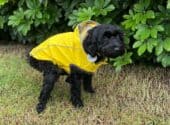Dog owners may well find themselves perplexed when they happen to spot a white mark on their canine’s nose. Is this an issue that requires attention? Or is it simply another distinguishing feature that adds to their pet’s individual character? By familiarizing oneself with the meaning of this discoloration, both purebred and mixed breed dog owners can rest easy knowing there is no reason to fear.
This article provides a comprehensive answer to the inquiry that has been occupying the minds of dog owners all over: What does a white spot on my dog’s nose mean? We will delve into various potential situations which might have caused this phenomenon and offer insight into its prevention.

Causes Of White Spots On Dog’s Nose
Here are the potential causes of white spots on dogs’ noses.
Loss of Pigment
The amount of coloration, or pigmentation, seen on a dog’s nose connected to the presence of melanin. In specific instances, the genes responsible for making melanin may not be expressed fully leading to areas with reduced or no pigment.
A depigmentation of the skin may result in a white spot developing on a dog’s nose. This visual difference from other areas of the nose can be attributed to multiple genetic factors that exist within identifiable dog breeds. For example, Dalmatians and Bull Terriers are prone to having pale noses due to their genetics allowing for less melanin production, which is responsible for pigmentation of both the hair and skin in dogs.
Trauma or injury to the nose may cause depigmentation. Physical damage to a dog’s nose can lead to white spots during the healing process due to a disruption of pigment in the affected area. Moreover, inflammatory issues, including autoimmune disorders and dermatitis, may also hinder pigmentation.
Medical conditions such as vitiligo could be indicated if white spots appear on a dog’s nose. Vitiligo is an autoimmune disorder in which the immune system mistakenly attacks melanocytes, cells that are responsible for providing pigment to the skin and hair. The exact cause of vitiligo is unknown, but genetic factors may be involved, along with environmental stressors or hormonal imbalances.
For canines suffering from vitiligo, the depigmentation of the nose can cause white spots to form. These blotches may come in a variety of sizes and shapes; moreover, their manifestation is dependent upon each individual animal’s condition. The lack of melanin pigment is accountable for this phenomenon since it is responsible for giving skin its ordinary hue; accordingly, in severe cases the nose may seem paler or even completely whitened.
It is essential to understand that vitiligo-induced depigmentation of the dog’s nose has no negative physical effects nor does it result in impaired health.
Pimples
Canine acne typically occurs in young dogs, usually around puberty, and is more common in certain breeds with short coats, such as Boxers, Bulldogs, and Rottweilers. It manifests as small, red bumps that resemble human pimples and can appear on the dog’s chin, lips, muzzle, and occasionally the belly or genital area.
In most cases, canine acne is a mild issue that resolves without treatment. If, however, the pimples persist or become more inflamed and cause distress to the dog, it is advisable to consult a veterinarian for evaluation. A proper examination of the dog’s skin can lead to an accurate diagnosis and suggest appropriate treatment if necessary, as other conditions such as allergies or skin infections may produce similar symptoms.
Depending on the severity of a canine’s acne, a variety of treatments may be recommended. Mild cases can often be addressed through home care habits, including washing the area with an appropriate and gentle cleanser for dogs as well as utilizing stainless steel or ceramic dishes instead of plastic ones. However, more extreme cases may necessitate topical interventions such as benzoyl peroxide or antibacterial shampoos from the veterinarian in order to manage inflammation and inhibit bacteria growth.
It is crucial to abstain from pinching or forcibly popping pimples, as this may create increased pressure and the possibility for infection.
Sunburn and Photodermatitis
Dogs with with light coats, small hairs, and areas of skin typically left unprotected such as the ears, nose, and abdomen may be particularly susceptible to sunburns and photodermatitis.
Due to overexposure of ultraviolet radiation from the sun, an inflammation and reddening of the skin may present itself as a result of sunburn; this is especially true for dog breeds with thin or light-hued noses. In extreme circumstances, peeling and discoloration such as white spots may arise during the healing process.
On the other hand, photodermatitis is a type of skin reaction which results from direct exposure to ultraviolet light emitted by either natural or artificial sources. This phenomenon can arise due to varied causes, such as medicinal treatments, certain compounds, and elements which amplify the skin’s sensitivity when exposed to sunlight. In canines, the symptoms consist of inflammation; blistering; ulceration; and upon recovery, white patches on the nose region may be identified.
Sunburn and photodermatitis both indicate damage to the skin of a dog due to excessive UV radiation or light exposure. To protect a dog’s nose from extended sun exposure, particularly during hours where the rays of the sun are strongest, it is vital that pet owners use safety measures like applying pet-friendly sunscreen or employing protective attire like hats or nose covers. In doing so, they can help avoid cases of sunburn and photodermatitis.
Snow Nose or Hypopigmentation
Canine hypopigmentation, commonly referred to as “snow nose” or “winter nose,” is a condition where areas of the canine’s nose become depigmented during colder months. This phenonmenom is typically observed in breeds with black or dark-colored noses such as Labradors, German Shepherds, Siberian Huskies and Golden Retrievers. Ultimately it should not cause significant concern from pet owners due to being mostly harmless and transient in nature.
Accordingly, snow nose can be triggered by both genetic and environmental aspects. The notion is that a combination of lower exposure to the sun’s rays along with predetermined genetics leads to the occurrence of white patches on the dog’s snout. As temperatures drop during winter, there generally becomes a decrease in the production of melanin which affects pigmentation of fur or skin. So then this reduction in melanin production may bring about a lightening or even vanishing of color from one part of the dog’s nose.
It is essential to recognize that snow nose, although visually apparent, does not result in any detrimental physical health effects for the dog. In reality, these dogs will normally retain their function despite a lack of pigmentation on the tip of their snout; typically when exposed to heightened exposure of sunlight at variance points throughout the year, this discoloration will dissolve.
Discoid Lupus Erythematosus (DLE)
Discoid Lupus Erythematosus (DLE) is a chronic form of autoimmune skin disorder which can lead to depigmentation and white spots manifesting on the nose of a canine. This particular illness commonly impacts epidermal areas in exposure to sun, including facial regions such as noses, ears and faces and tends to be more noticeable within specified dog breeds like Collies, German Shepherds or Shetland Sheepdogs.
The exact cause of DLE is still unclear, however, it is suspected that both genetic and environmental factors have an influence. In dogs affected by DLE, their immune system mistakenly attacks healthy skin cells which then causes inflammation and harm to the tissues. As a result of this recurring inflammatory process, melanocytes, or pigment-producing cells, can be destroyed thereby leading to white spots on the dog’s coat.
A vet must conduct a detailed evaluation to accurately diagnose DLE, including examination of the patient’s medical history, physical assessment and potentially a skin biopsy. The examination is necessary in order to reveal certain changes in the skin indicative of DLE such as infiltration of immune cells and damage to the deeper layers.
Kennel Nose
Kennel Nose, otherwise referred to as Nasal Hyperkeratosis, involves the emergence of white spots or crusty growths on a dog’s nose and is not limited to only those dogs kept in kennels or exposed to severe environmental conditions. In fact, the condition has been observed in different breeds, such as Bulldogs, Boxers and Labrador Retrievers despite their residing environment; it can affect any dogregardless of its breed or age.
When a dog has developed Kennel Nose, the skin on their nose will experience a lack in moisture and elasticity. This then leads to an accumulation of more keratin than usual, which is a protein responsible for forming hair, nails, and external layers of skin. As a result, the impacted part of their nose will become rough, scaly and discolored with white spots or patches being the most common.
Treatment for Kennel Nose seeks to provide relief by moisturizing and softening the affected skin. Examples of remedies that can be employed include topical products with moisturizing components like shea butter, coconut oil, or vitamin E. The area should be routinely massaged with these items in order to act on the thickened skin and reduce the formation of white spots.
Are White Spots on a Dog’s Nose Preventable?

The extent to which white spots on a dog’s nose can be prevented is dependent upon the underlying cause.
If the dog is part of a breed that often demonstrates white spots on the nose, it may not be avoidable due to its genetic makeup. Certain breeding practices can reduce likelihood of such traits emerging; however, completely eliminating this characteristic without removing its hereditary element could prove unattainable.
In addition, nose injuries or trauma can cause white spots as scar tissues may form during the healing process. It is not always possible to prevent such accidents from taking place, however one can take steps to reduce the chances of a problem occurring. To achieve this goal, one should shield their dog from rough environments and ensure they have a secure living area.
In order to prevent discoloration and depigmentation of the nose due to excessive sun exposure, safeguard your dog from potential UV damage by limiting their sun exposure especially at the most intense times of day. To minimize risk further, offer shade or apply pet-safe sunscreen on exposed areas.
For pooches affected by vitiligo, which is a condition resulting in the loss of pigmentation in the skin and can afflict any area of the body including the nose, there are usually no preventative measures available as it is often triggered by hereditary factors. Although there has yet to be discovered a cure for this condition, attempts have been made to limit its progression with various treatments.
In regards to Discoid Lupus Erythematosus (DLE), prevention may not be an option, however early recognition and appropriate treatment can help mitigate the growth of the disorder and decrease symptoms, including white spots on a dog’s nose.
Final Thoughts
It is uncertain whether white spots on a dog’s nose will diminish in the absence of intervention. If such blemishes are caused by temporarly coniditions, namely sunburn or depigmentation, they may improve as the tissue heals. Nonetheless, if their cause is more lingering or genetic in nature then it could be likely for these blemishes to remain visible yet become less pronounced over time. Thus, seeking consultation with a veterinarian would be beneficial should you have concerns about white spots occuring on your pet’s nose.




